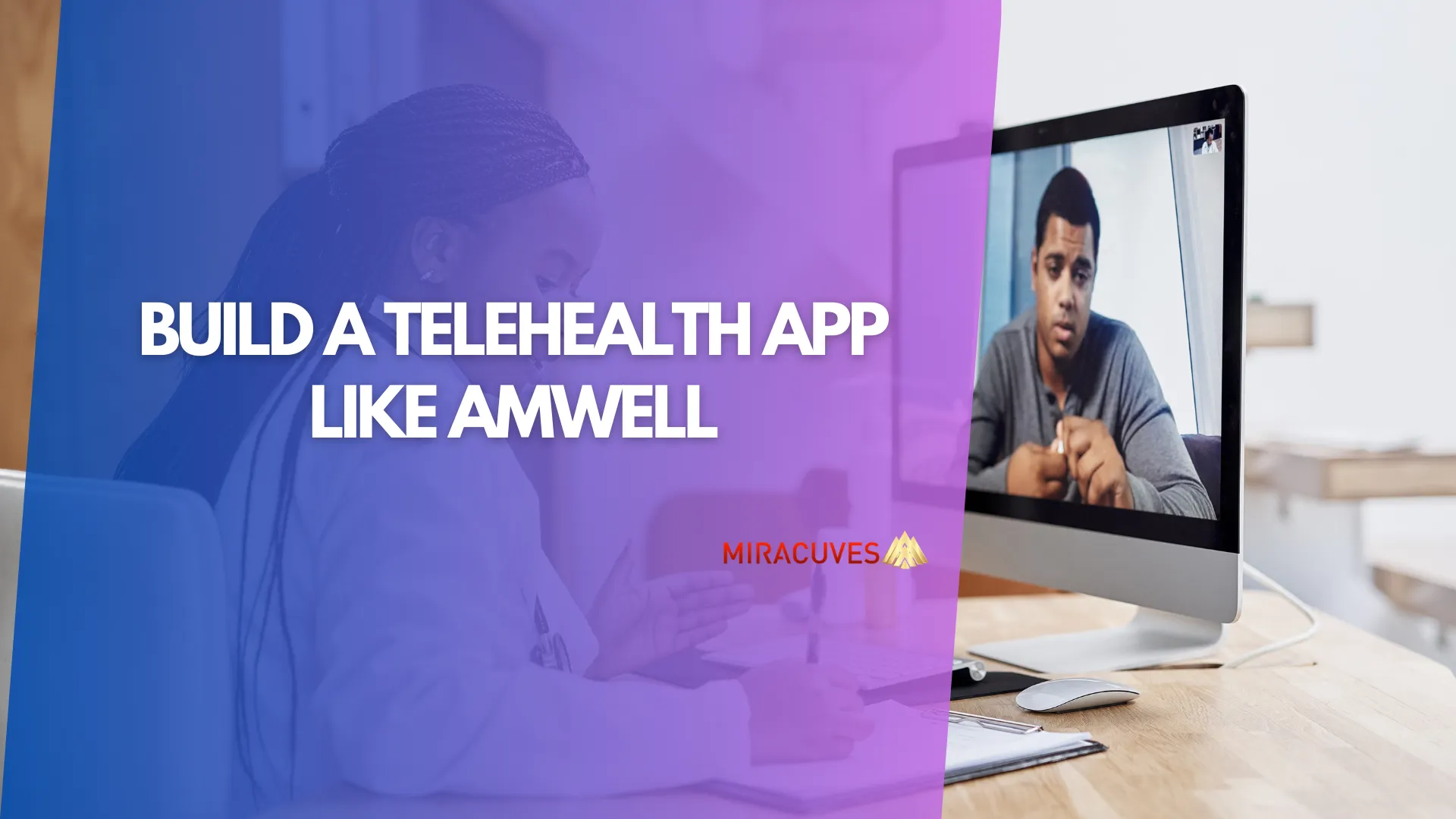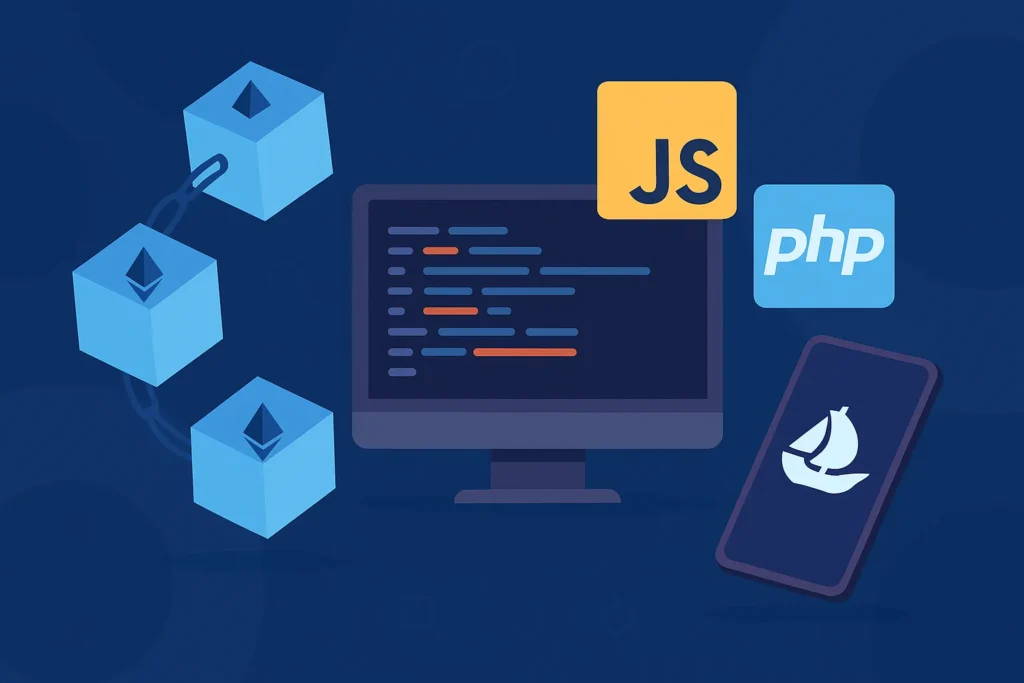Telehealth has become a cornerstone of modern healthcare, allowing patients and providers to connect remotely through online platforms. Among the pioneers in this space, Amwell stands out as a comprehensive virtual healthcare solution, offering services like remote doctor consultations, mental health therapy, and chronic care management. With the rise in demand for online healthcare services, building an app like Amwell has become a lucrative opportunity for businesses looking to enter the digital health space.
Creating a telehealth platform involves more than just technology. It requires careful planning, compliance with healthcare regulations, and integration of user-friendly features. This is where Miracuves Solutions comes into play, providing ready-made app designs at 10% of the global cost and delivering projects 30 times faster than traditional providers. If a typical development process takes a month, Miracuves Solutions can help you launch your telehealth app in just one day.
This guide will walk you through every step of building a telehealth app like Amwell, including key features, technical requirements, cost analysis, and future growth trends. Whether you’re an entrepreneur, a healthcare provider, or a business looking to enter the telemedicine market, this article has everything you need to get started.
What is Amwell, and What Does It Do?
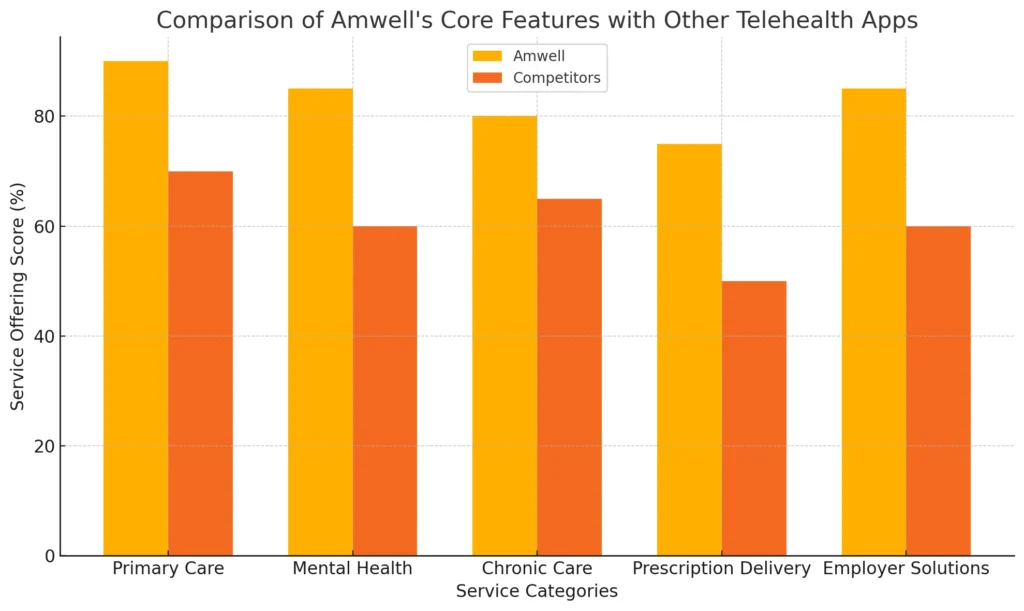
Amwell is a leading telehealth platform that connects patients with healthcare providers through virtual consultations. It offers a seamless way for individuals to access healthcare services without visiting a clinic or hospital physically. From primary care and mental health services to chronic condition management, Amwell provides comprehensive medical care remotely. Patients can book appointments, consult with doctors via video or chat, receive prescriptions, and even have medications delivered to their doorsteps.
This platform stands out for its focus on convenience and accessibility. Users can access the service via mobile apps, tablets, or desktops, allowing healthcare to fit into their schedules and comfort. Beyond individual consultations, Amwell also collaborates with hospitals, insurance providers, and employers to deliver customized healthcare solutions.
The platform addresses many challenges faced by traditional healthcare systems, such as long waiting times, limited access to specialists, and geographical barriers. With secure video technology and electronic health record (EHR) integration, Amwell ensures patient privacy while maintaining accurate medical histories.
The rapid growth of remote healthcare solutions like Amwell highlights a shift towards patient-centered care, making telemedicine the future of healthcare. For those looking to build a similar platform, it’s essential to understand the core functionalities that make Amwell successful. These functionalities will serve as the foundation for your own telehealth app.
Why Should You Build This App?
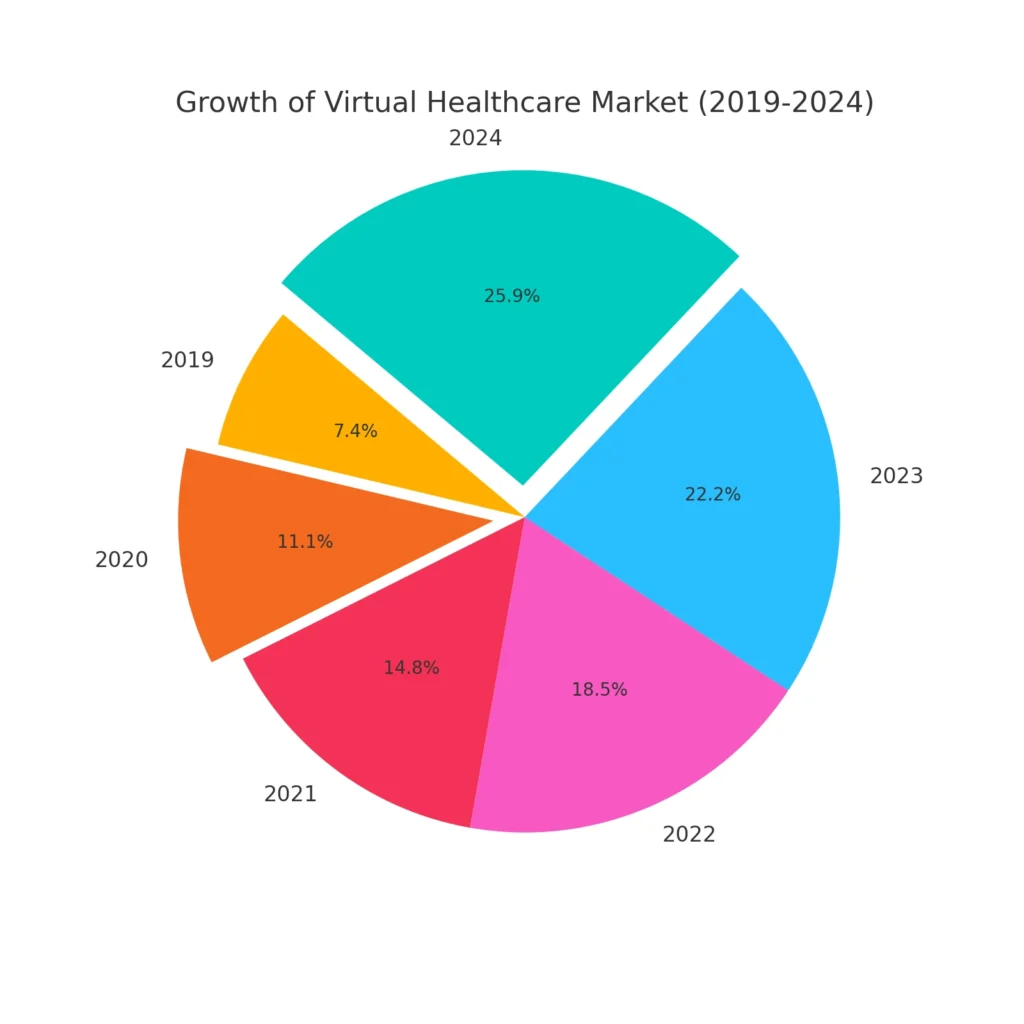
The global healthcare landscape is rapidly evolving, and telemedicine is at the forefront of this transformation. Platforms like Amwell have demonstrated how virtual healthcare solutions can address key challenges such as limited access to doctors, long waiting times, and geographical constraints. Building a telehealth app offers not only a chance to improve patient care but also a profitable opportunity to tap into a growing market.
Why Telehealth is the Future
The COVID-19 pandemic accelerated the shift to remote healthcare, and even in a post-pandemic world, the demand for virtual consultations continues to rise. Patients value the convenience of consulting doctors from the comfort of their homes, while healthcare providers benefit from improved efficiency and reduced overhead costs.
Additionally, governments and insurance companies are now embracing telemedicine by expanding coverage for virtual visits. This shift makes telehealth platforms more relevant and financially sustainable in the long term.
How Miracuves Solutions Helps You Succeed
Building a telehealth app requires technical expertise and careful planning, but traditional development can be costly and time-consuming. This is where Miracuves Solutions steps in, offering ready-made designs at just 10% of the global cost. While other providers may take a month to launch a product, Miracuves Solutions ensures your app goes live in just one day, providing a 30x faster time-to-market advantage.
Also Read:- Top 10 Ideas for Healthcare and Telemedicine Business Startups
How to Differentiate Your App from Competitors
In the highly competitive telehealth space, building a unique app is essential to stand out. While core features like video consultations and appointment scheduling are standard, offering additional value-driven functionalities can create a compelling reason for users to choose your platform. Below are strategies to ensure your app is a cut above the rest.
1. Focus on Niche Services
Specializing in areas like mental health support, pediatric care, or chronic disease management can attract targeted audiences. Unlike generalized platforms, niche services cater to specific needs, giving your app a loyal user base.
2. AI and Wearable Integration
Introducing AI-powered symptom checkers and wearable device integration for health tracking can enhance the user experience. These features provide proactive health monitoring, ensuring users stay engaged beyond consultations.
3. Personalized User Experience
Leveraging patient history data to offer personalized recommendations, such as diet plans or follow-up care, creates deeper connections with users. Incorporating multilingual support and easy accessibility features will further broaden your reach.
4. Loyalty Programs and Subscriptions
Implementing reward systems for frequent users and offering subscription models encourages long-term engagement. These incentives add value to users and drive recurring revenue.
| Feature | Amwell | Competitor A | Competitor B | Your App Idea |
|---|---|---|---|---|
| Video Consultations | Yes | Yes | Yes | Yes |
| AI Symptom Checker | No | No | Yes | Yes |
| Wearable Device Integration | No | Yes | No | Yes |
| Appointment Scheduling | Yes | Yes | Yes | Yes |
| Prescription Delivery | Yes | No | Yes | Yes |
| Multilingual Support | No | No | Yes | Yes |
| Mental Health Services | Yes | Yes | Yes | Specialized Mental Health |
| Loyalty Programs | No | No | No | Yes |
| Subscription Model | Yes | Yes | No | Yes |
Market Size, Growth, and Revenue Model
| Year | Global Market Value (in USD Billion) | CAGR (%) | Popular Revenue Models |
|---|---|---|---|
| 2021 | 49 | 24 | Pay-per-visit, Insurance |
| 2022 | 65 | 25 | Subscription Plans |
| 2023 | 82 | 25 | Pay-per-visit, Freemium |
| 2024 (Forecast) | 100 | 25 | Subscription, Insurance |
| 2030 (Forecast) | 460 | 25 | Mixed Revenue Models |
The telehealth industry has experienced explosive growth over the past few years, driven by technological advancements, shifting consumer behavior, and the impact of the COVID-19 pandemic. According to recent reports, the global telemedicine market is expected to reach $460 billion by 2030, with a compound annual growth rate (CAGR) of around 25% from 2021 to 2030.
This growth is fueled by increased healthcare digitization, government initiatives supporting remote care, and the rising demand for convenient healthcare solutions. Virtual consultations, chronic disease management, and mental health support are becoming mainstream, further expanding the market.
According to a recent report, the global telehealth market is expected to reach $460 billion by 2030.
Revenue Models to Consider for Your Telehealth App
- Pay-Per-Visit: Users pay a fee for each consultation, making this model easy to implement.
- Subscription Plans: Offer premium services through monthly or yearly subscriptions, ensuring recurring revenue.
- Insurance Partnerships: Collaborate with insurers to offer virtual care as part of their coverage plans.
- Freemium Model: Provide basic consultations for free and charge for advanced features or specialist appointments.
These revenue streams allow your app to adapt to different market needs, ensuring sustainable growth while meeting user expectations.
Features of the App
Building a telehealth app like Amwell requires integrating a wide range of features to ensure smooth operation for both patients and healthcare providers. These features should focus on usability, convenience, and security to provide the best virtual healthcare experience.
Core Features
- Video Consultations:
- High-quality video calls between doctors and patients for remote assessments.
- Appointment Scheduling:
- Easy-to-use calendar system to book and manage appointments.
- Prescription Management:
- Doctors can send prescriptions digitally, and patients can receive medication through integrated delivery partners.
- Payment Gateway Integration:
- Secure payment methods supporting credit cards, digital wallets, and insurance processing.
- Electronic Health Records (EHR):
- Store patient medical histories securely for quick access during consultations.
Optional Features for Added Value
- AI Symptom Checker:
- Provides users with preliminary health assessments before consulting a doctor.
- Wearable Device Integration:
- Sync with fitness trackers or smartwatches to monitor vital signs remotely.
- Chat and Notification System:
- In-app chat for follow-ups and notifications for appointment reminders or prescription updates.
These features help create an all-in-one healthcare platform, ensuring patients receive end-to-end medical care without leaving their homes.
Also Read:- How to Build an App like Practo: A Complete Guide to Telemedicine Success
Technical Requirements
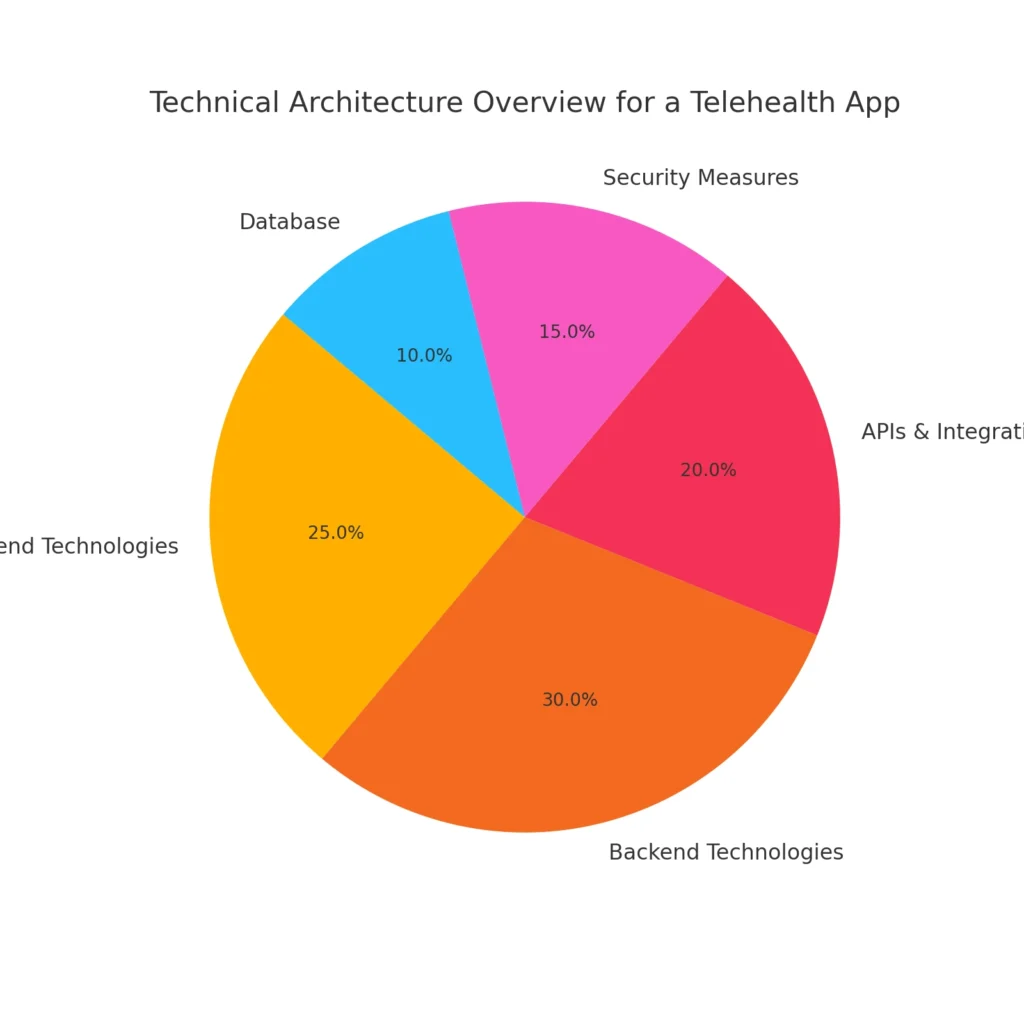
Building a telehealth app like Amwell demands the right technology stack to ensure smooth performance, scalability, and security. The core of the technical framework revolves around backend infrastructure, frontend technologies, secure data storage, and third-party API integrations.
Frontend Technologies
- React Native or Flutter: For developing cross-platform mobile applications.
- HTML5 and CSS3: To create web-friendly, responsive designs.
Backend Technologies
- Node.js or Django: For managing server-side logic and fast API responses.
- MongoDB or PostgreSQL: To store medical records securely.
API Integrations
- Payment Gateway APIs: Stripe, PayPal for seamless transactions.
- EHR System APIs: Integrate with existing health records to maintain patient history.
- Video Call APIs: Twilio or Zoom SDK for high-quality consultations.
Security Requirements
- HIPAA Compliance: To protect sensitive patient data and ensure privacy.
- Data Encryption: Safeguard all communications and stored records.
- Two-Factor Authentication (2FA): For secure user login.
This robust tech stack ensures your app operates efficiently while providing seamless interactions between users and healthcare providers. By integrating modern APIs, you’ll offer an engaging experience that keeps both patients and providers satisfied.
Design and User Interface
| Design Element | Telehealth App | Traditional Healthcare App |
|---|---|---|
| Navigation | Simple and intuitive | More complex, multiple screens |
| Mobile Optimization | Mobile-first, responsive design | Often desktop-centric |
| Appointment Booking | Quick, in-app scheduling | Requires multiple steps |
| Multilingual Support | Frequently included | Rarely prioritized |
| Dashboard | Patient and provider dashboards | Limited functionality |
| Accessibility Features | Advanced (e.g., voice commands) | Limited accessibility options |
The design and user interface (UI) of a telehealth app are crucial for ensuring that both patients and healthcare providers have a smooth and enjoyable experience. A well-thought-out UI/UX design not only enhances usability but also builds trust and engagement with users.
Key Principles for Telehealth App Design
- Simplicity and Ease of Navigation
- The interface should be intuitive, making it easy for users to book appointments, join video calls, and manage their health records.
- Use clear icons and minimal clicks for better accessibility.
- Mobile-First Approach
- With most users accessing healthcare via smartphones, the app must be optimized for mobile devices to deliver a seamless experience.
- Ensure responsive design for tablets and desktops to cater to all users.
- Accessible Design Features
- Include multilingual support and voice commands to accommodate diverse user groups.
- Add color-blind friendly palettes and adjustable text sizes for enhanced accessibility.
- Provider and Patient Dashboards
- A simple dashboard for patients to manage appointments, prescriptions, and payment history.
- A separate interface for doctors to track consultations and manage patient records efficiently.
A user-friendly design ensures higher engagement and satisfaction, encouraging users to stay connected with healthcare services through your platform.
Development Process
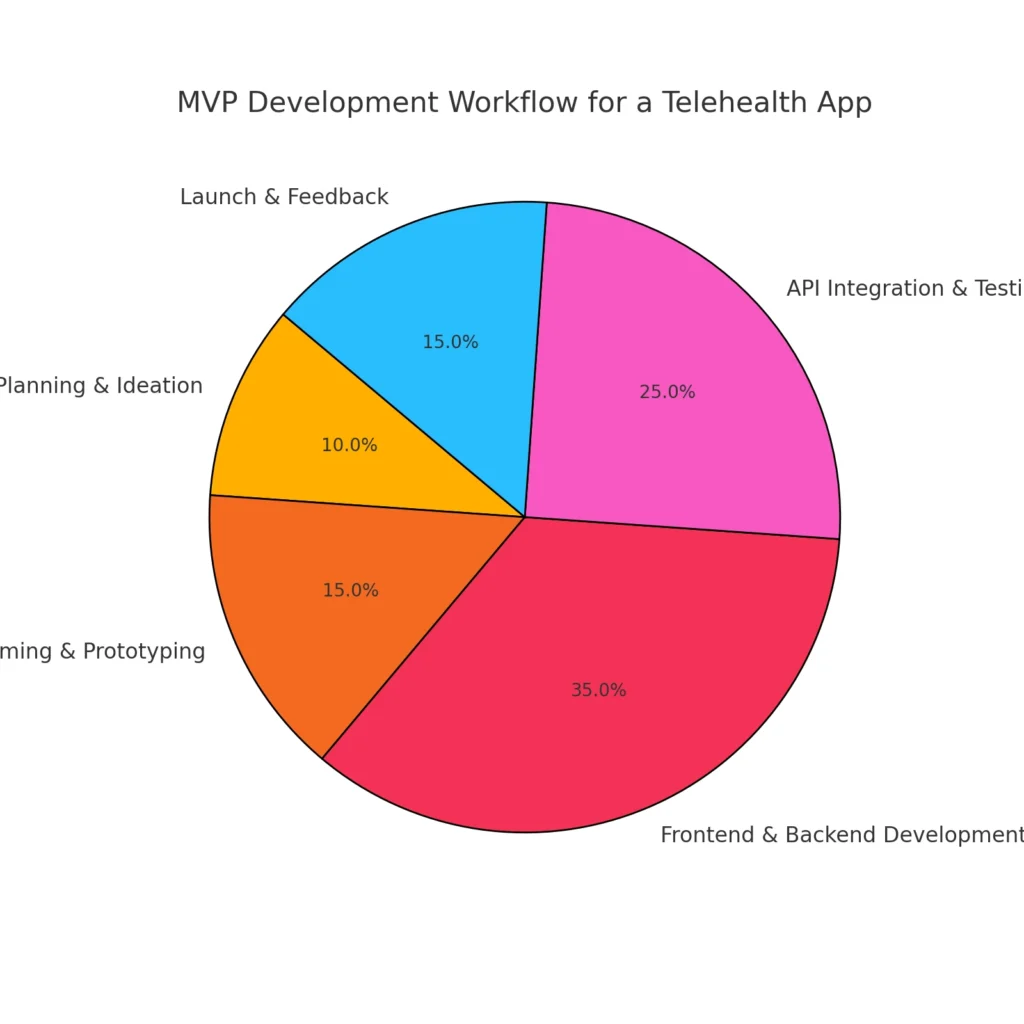
Building a telehealth app like Amwell requires a structured step-by-step approach to ensure every component functions seamlessly. A well-planned development process starts with building a Minimum Viable Product (MVP) and evolves through testing, iterations, and deployment. Below is a breakdown of the essential stages.
Step 1: MVP Development
An MVP helps you validate the core idea with minimal resources by focusing on essential features, such as video consultations, appointment scheduling, and payment integration. Once the MVP is live, feedback from early users can guide future improvements.
Step 2: Prototyping and Wireframing
- Create wireframes and prototypes to map out the user journey and define the look and feel of the app.
- Involve stakeholders early to ensure the design aligns with user expectations.
Step 3: Frontend and Backend Development
- Frontend Development: Use frameworks like React Native or Flutter to build a responsive interface for mobile and web users.
- Backend Development: Implement Node.js or Django for a secure and fast-performing backend, supporting real-time consultations.
Step 4: API Integration and Testing
- Integrate essential APIs such as Twilio for video calls, Stripe for payments, and EHR systems for patient records.
- Conduct extensive testing to ensure the app works seamlessly across devices and scenarios.
Step 5: Launch and Post-Launch Monitoring
- Deploy the app on Google Play Store, Apple App Store, and web platforms.
- Monitor performance metrics and fix bugs based on user feedback.
By following this structured approach, you can reduce development risks and ensure a smooth launch.
Also Read :- Step-by-Step Guide to Building a Remote Healthcare App Like Teladoc
Cost Estimation and Timeframe
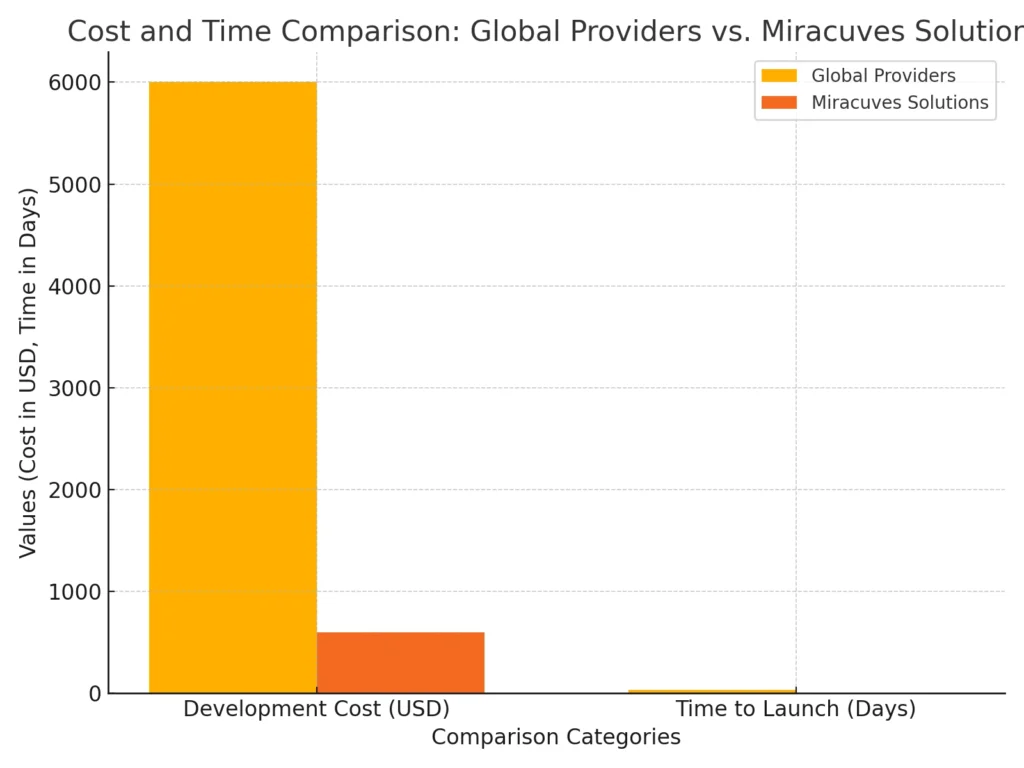
Building a telehealth app like Amwell requires a careful balance of budget, time, and resources. However, the development cost can vary significantly depending on the features, design complexity, and technology stack you choose. Below is a breakdown of typical development costs and timelines, compared with the efficient solutions offered by Miracuves Solutions.
Global vs. Miracuves Solutions: Cost Comparison
- Global Cost: Developing a feature-rich telehealth app from scratch can cost $6000 or more. This includes expenses for design, development, testing, and deployment.
- Miracuves Solutions: By leveraging ready-made solutions and a streamlined development process, Miracuves Solutions can create the same app for just $600—only 10% of the global cost.
Global vs. Miracuves Solutions: Timeframe Comparison
- Global Development Time: Typically, it takes 1 month or more to build and deploy a telehealth app due to extensive design and testing phases.
- Miracuves Solutions: With a ready-made approach, the app can go live in just 1 day, providing a competitive advantage in time-sensitive markets.
Choosing a solution like Miracuves Solutions not only saves you money but also allows you to launch quickly, ensuring you don’t miss out on business opportunities.
Ready to build an app that improves patient care and business efficiency?
Our expert team will guide you every step of the way.
Why Trust Miracuves Solutions for Your Next Project?
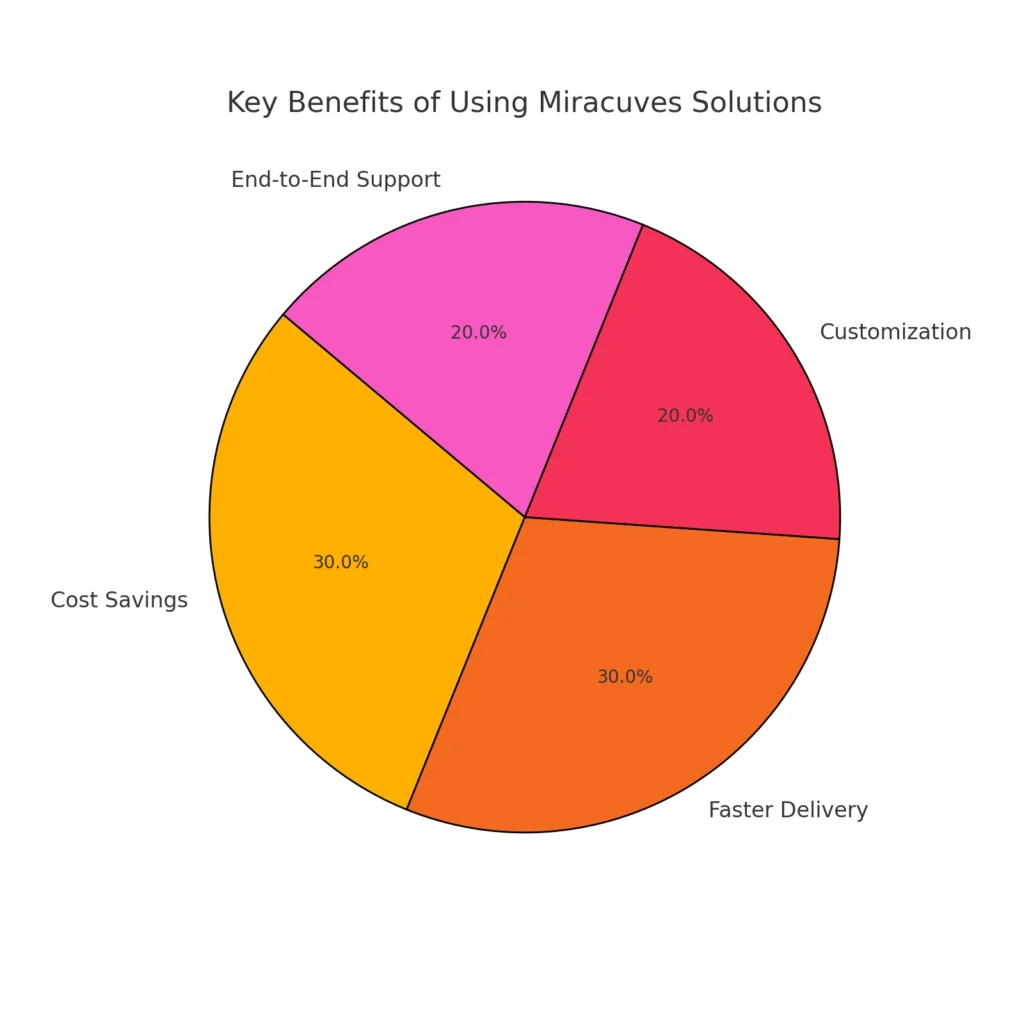
Choosing the right development partner can make or break your app’s success, especially in the competitive telehealth industry. Miracuves Solutions stands out by offering high-quality, cost-effective, and lightning-fast solutions. Here’s why you can trust Miracuves Solutions for your next telehealth app project:
1. Cost-Effective Development
Miracuves Solutions leverages ready-made designs and a streamlined development process to deliver top-tier apps at 10% of the global cost. This allows you to save on development expenses without compromising on quality.
2. Speed Like No Other
In today’s fast-moving market, time is critical. While most providers take weeks or months to launch an app, Miracuves Solutions ensures your product is live within 1 day—giving you a massive time-to-market advantage.
3. Proven Expertise and Customization
Miracuves Solutions has a track record of delivering scalable apps across industries. Although the company uses ready-made solutions, the solutions are highly customizable, giving your app a unique edge that aligns with your business goals.
4. Support at Every Stage
From planning and development to post-launch maintenance, Miracuves Solutions offers end-to-end support. This ensures your app runs smoothly, with minimal downtime and maximum efficiency.
By choosing Miracuves Solutions, you benefit from cost savings, faster delivery, and reliable service—the perfect formula to bring your telehealth app idea to life.
Monetization Strategies
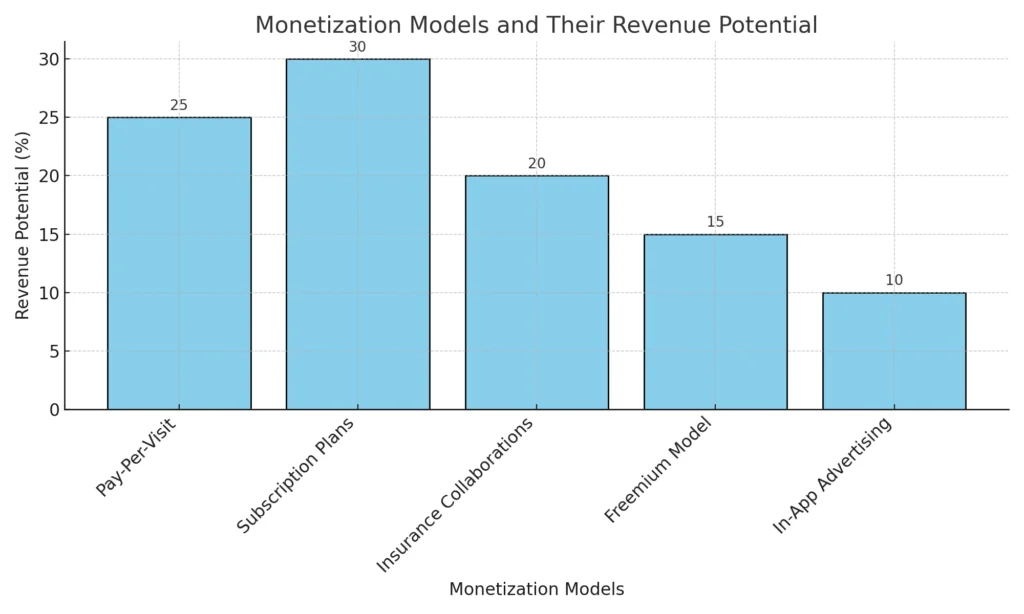
A well-planned monetization strategy is essential to ensure your telehealth app not only serves patients but also generates sustainable revenue. Successful apps like Amwell leverage multiple revenue streams, and with the right approach, your app can do the same. Below are the most effective monetization strategies for a telehealth app:
1. Pay-Per-Visit Model
- Users pay for each consultation they book. This is a simple, straightforward revenue stream that works well for platforms offering one-time services or specialist consultations.
2. Subscription Plans
- Offer monthly or yearly subscriptions that include unlimited access to consultations, mental health support, or exclusive features. This ensures recurring revenue and encourages long-term engagement.
3. Insurance Collaborations
- Partner with insurance providers to make virtual healthcare part of their coverage. This strategy increases user base, as patients can access services without worrying about out-of-pocket expenses.
4. Freemium Model
- Provide basic services for free and charge for premium features such as advanced diagnostics or priority doctor appointments. This model attracts a wider audience while generating revenue from high-value users.
5. In-App Advertising
- Collaborate with healthcare brands to display relevant ads within the app. However, ensure that the ads don’t interfere with the user experience.
Each of these models can be tailored to meet the specific needs of your target market, creating a revenue-generating ecosystem that sustains and grows with time.
Launching and Marketing the App
| Marketing Strategy | Pre-Launch | Launch Phase | Post-Launch |
|---|---|---|---|
| SEO & ASO Optimization | Yes | Ongoing | Ongoing |
| Social Media Campaigns | High Focus | Moderate | Moderate |
| Partnerships & Collaborations | Limited | High Focus | High Focus |
| Press Releases & Media | Minimal | High Focus | Moderate |
| Loyalty Programs & Referrals | Not Applicable | Minimal | High Focus |
| User Engagement (Push Notifications) | Not Applicable | Minimal | High Focus |
The successful launch of your telehealth app requires more than just technical readiness. A solid marketing strategy ensures that the app reaches your target audience, gains momentum, and creates a lasting impression. Below are the key steps for launching and promoting your app effectively:
1. Pre-Launch Marketing
- SEO and ASO Optimization:
Ensure your app is search-engine optimized for keywords like “virtual healthcare” and “online doctor consultation.” Implement App Store Optimization (ASO) to improve discoverability on platforms like Google Play and Apple’s App Store. - Social Media Campaigns:
Generate buzz with targeted ads and engaging posts on platforms such as Instagram, Facebook, and LinkedIn. Use teaser campaigns to attract early users.
2. Collaborate with Healthcare Networks and Influencers
- Partner with hospitals, clinics, and insurance providers to promote your app. Influencers in the healthcare space can also boost your app’s visibility by endorsing it.
3. Launch Strategy
- Soft Launch:
Start with a soft launch to gather feedback from a limited audience. This allows you to fix any bugs and improve usability before a wider release. - Official Launch:
Plan an official launch event and use press releases to announce your app’s arrival to the public.
4. Post-Launch Marketing and User Engagement
- Loyalty Programs and Referrals:
Encourage users to invite others by offering rewards for referrals. Loyalty programs incentivize continuous use. - Continuous Engagement:
Use push notifications and personalized messages to keep users active on your platform.
With the right marketing strategy, your app can gain early traction and grow steadily through word-of-mouth and digital promotions.
Legal and Regulatory Considerations
Developing a telehealth app involves navigating legal regulations and compliance standards to protect patient data and ensure ethical healthcare practices. Non-compliance can result in heavy fines and loss of user trust. Here are the key legal aspects to consider:
1. HIPAA and GDPR Compliance
- HIPAA (Health Insurance Portability and Accountability Act) applies to healthcare services in the United States. It ensures the confidentiality and security of patient information.
- GDPR (General Data Protection Regulation) governs data privacy across the European Union. It requires apps to obtain explicit user consent before collecting personal data.
2. Data Encryption and Security Standards
- Implement end-to-end encryption to protect all communications between patients and healthcare providers.
- Ensure secure storage of patient data, following industry best practices like AES encryption and regular audits.
3. Medical Licensing and Permits
- Doctors offering consultations must have the appropriate licenses to practice in the user’s geographical region. Ensure your platform supports only verified professionals.
4. Informed Consent
- Collect informed consent from patients before any consultation or treatment. Provide terms of service and privacy policies that clearly explain how their data will be used.
5. Telehealth-Specific Regulations
- Some regions may have specific telehealth regulations governing virtual consultations, prescriptions, and insurance coverage. Keep your app updated with the latest regulations to maintain compliance.
Navigating the legal landscape ensures your app operates smoothly and earns the trust of users, healthcare providers, and regulators alike.
Your telehealth app must comply with HIPAA guidelines to ensure patient data is protected and meets U.S. healthcare standards.
Future Growth and Trends
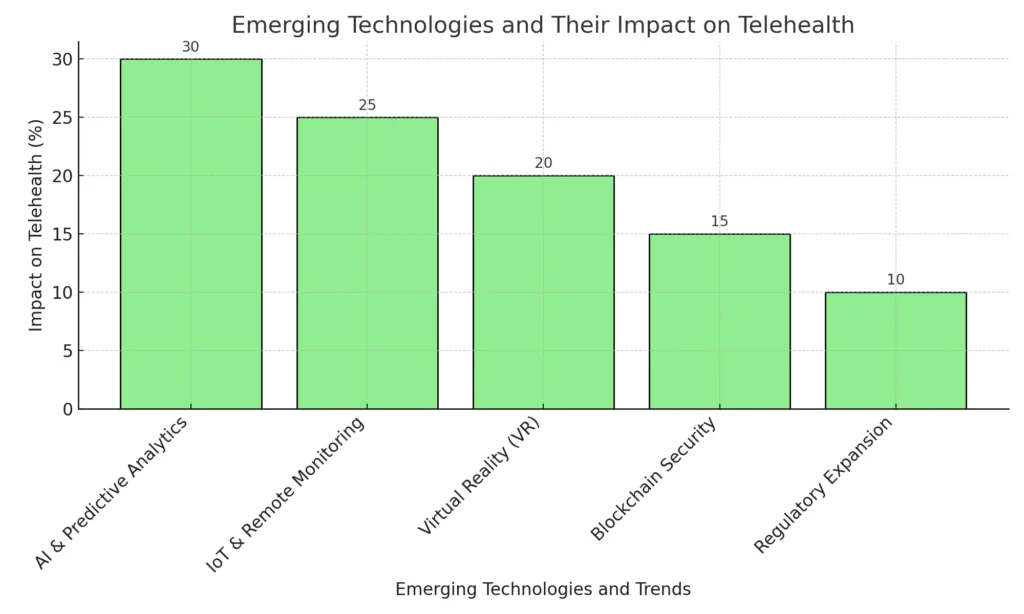
The telehealth industry is set to experience exponential growth, fueled by continuous innovation and changing consumer behavior. As new technologies emerge, telehealth apps must evolve to stay relevant. Here are some key trends that will shape the future of virtual healthcare:
1. AI and Predictive Analytics
Artificial Intelligence (AI) will play a significant role in automating diagnoses and offering personalized care plans. Predictive analytics can help doctors detect potential health issues early, improving patient outcomes.
2. Remote Monitoring with IoT
With the rise of wearable devices and Internet of Things (IoT) technology, healthcare providers can monitor patients remotely in real-time. Devices like smartwatches and fitness trackers will help in chronic disease management by continuously tracking vital signs.
3. Virtual Reality (VR) for Mental Health Therapy
VR technology is already being used for immersive mental health therapy, helping patients overcome anxiety, PTSD, and phobias. Future telehealth apps may integrate VR modules to offer specialized mental health care.
4. Blockchain for Data Security
Blockchain technology will enhance the security and transparency of medical records, ensuring patient data remains tamper-proof while being easily accessible across platforms.
5. Expansion of Telehealth Regulations
As telehealth gains more traction, governments and regulatory bodies will refine policies to support its expansion. This will make it easier for healthcare providers to offer virtual services across borders.
By embracing these trends, your app can stay ahead of the curve and meet the changing demands of the healthcare market, ensuring long-term success.
Also Read :- How to Build an App like Practo: A Complete Guide to Telemedicine Success
Conclusion
Building a telehealth app like Amwell offers an incredible opportunity to revolutionize healthcare by providing patients with easy access to virtual medical services. From consultations and remote monitoring to mental health support, telehealth apps are meeting modern healthcare needs efficiently and affordably. The future of healthcare is digital, and having the right features, technology, and business model will ensure your app becomes a key player in this thriving industry.
Miracuves Solutions stands out as your ideal partner in this journey, offering cost-effective and fast solutions with ready-made solutions. While global providers may take weeks and cost thousands, Miracuves Solutions delivers high-quality telehealth apps within just one day, at 10% of the global cost. By trusting Miracuves, you get a competitive advantage in both time and resources.
Whether you’re a startup or a healthcare provider, the insights from this guide will help you navigate every aspect of building a telehealth app—from MVP development to post-launch marketing. With the right strategy and technology, your app can achieve sustainable growth and make healthcare more accessible for everyone.
Have a vision for a healthcare app?
Let’s Talk About Your Healthcare App Vision how we can bring it to life with innovative solutions and secure
technology.
FAQs
How long does it take to build a telehealth app?
With traditional providers, it can take up to a month or more. However, Miracuves Solutions offers ready-made solutions that can launch your app in just one day.
What is the typical cost of building a telehealth app?
Globally, telehealth app development can cost around $6000 or more, but Miracuves Solutions delivers it at just $600.
Can I customize the app to suit my business needs?
Yes, Miracuves Solutions provides ready-made solutions, ensuring your app reflects your unique branding and services.
Does the app comply with HIPAA and GDPR regulations?
Absolutely. The app will follow HIPAA and GDPR guidelines, ensuring patient data privacy and security.
What features are essential for a telehealth MVP?
Your MVP should include video consultations, appointment booking, payment integration, and prescription management to ensure quick validation of the core idea.
Explore smart healthcare solutions by Miracuves – designed for accessibility, ease of use, and reliable care:
- Netmeds Like Solution – A user-friendly solution for ordering medicines online, uploading prescriptions, and receiving doorstep delivery.
- Practo Like Solution – A comprehensive solution for scheduling doctor appointments, managing health records, and accessing teleconsultations.
- Customizable PharmEasy Like Solution – A flexible solution that simplifies ordering medicines, booking diagnostic tests, and accessing healthcare products.
- Lybrate Like Solution – A trusted solution for connecting with doctors, receiving instant medical advice, and scheduling follow-up consultations.



